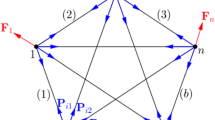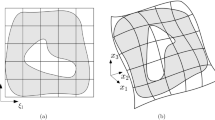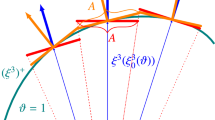Abstract
Kirchhoff type shells are continuum models used to study the mechanics of thin elastic bodies; these are largely based on the theory of surfaces. Here, we report a reformulation of Kirchhoff shells using the theory of moving frames. This reformulation permits us to treat the deformation and the geometry of the shell as two separate entities. The structure equations which represent the familiar torsion and curvature free conditions (of the ambient space) are used to combine deformation and geometry in a compatible way. From such a perspective, Kirchhoff type theories have non-classical features which are similar to the equations of defect mechanics (theory of dislocations and disclinations). Using the proposed framework, we solve a boundary value problem and thus demonstrate, to an extent, the importance of moving frames.



Similar content being viewed by others
Notes
A curve is regular if the tangent vector does not vanish.
Even though this assumption is always made in a classical continuum theory, it is never explicitly stated.
References
Arbind A, Reddy J, Srinivasa A (2019) A nonlinear 1-d finite element analysis of rods/tubes made of incompressible Neo–Hookean materials using higher-order theory. Int J Solids Struct 166:1–21
Arbind A, Srinivasa A, Reddy J (2018) A higher-order theory for open and closed curved rods and tubes using a novel curvilinear cylindrical coordinate system. J Appl Mech 85(9). https://doi.org/10.1115/1.4040335
Bishop RL (1975) There is more than one way to frame a curve. Am Math Mon 82(3):246–251
Clelland JN (2017) From Frenet to Cartan: the method of moving frames, vol 178. American Mathematical Society, Providence, RI
Deserno M (2015) Fluid lipid membranes: from differential geometry to curvature stresses. Chem Phys Lipids 185:11–45
Dvorkin EN, Bathe KJ (1984) A continuum mechanics based four-node shell element for general non-linear analysis. Eng Comput 1(1):77–88
Eringen AC (2002) Nonlocal continuum field theories. Springer, New York
Eringen AC (2012) Microcontinuum field theories: I. foundations and solids. Springer, New York
Guggenheimer H (1963) Differential Geometry. McGraw-Hill series in higher mathematics, McGraw-Hill, New York
Guven J, Vázquez-Montejo P (2018) The geometry of fluid membranes: variational principles, symmetries and conservation laws. In: The role of mechanics in the study of lipid bilayers. Springer, New York, pp 167–219
Nampally P, Karttunen AT, Reddy J (2019) Nonlinear finite element analysis of lattice core sandwich beams. Eur J Mech A Solids 74:431–439
Romanoff J, Reddy J, Jelovica J (2016) Using non-local timoshenko beam theories for prediction of micro-and macro-structural responses. Compos Struct 156:410–420
Simo JC, Fox DD (1989) On a stress resultant geometrically exact shell model. Part I: formulation and optimal parametrization. Comput Methods Appl Mech Eng 72(3):267–304
Simo JC, Fox DD, Rifai MS (1990) On a stress resultant geometrically exact shell model. Part III: computational aspects of the nonlinear theory. Comput Methods Appl Mech Eng 79(1):21–70
Spivak M (1975) Differential geometry, vol 1–5. Publish or Perish, Berkeley
Srinivasa AR, Reddy J (2017) An overview of theories of continuum mechanics with nonlocal elastic response and a general framework for conservative and dissipative systems. Appl Mech Rev 69(3):030802
Toupin RA (1964) Theories of elasticity with couple-stress. Arch Ration Mech Anal 17(2):85–112
Wang CC (1968) On the geometric structure of simple bodies, a mathematical foundation for the theory of continuous distributions of dislocations. In: Mechanics of generalized continua. Springer, New York, pp 247–250
Yavari A, Goriely A (2012) Riemann–Cartan geometry of nonlinear dislocation mechanics. Arch Ration Mech Anal 205(1):59–118
Yavari A, Goriely A (2013) Riemann–Cartan geometry of nonlinear disclination mechanics. Math Mech Solids 18(1):91–102
Acknowledgements
BD was supported by ISRO through the Centre of Excellence in Advanced Mechanics of Materials; grant No. ISRO/DR/0133. BD would also like to thank Prof. Arun Srinivasa, TAMU for helpful discussions.
Author information
Authors and Affiliations
Corresponding author
Ethics declarations
Conflict of interest
The authors declare that they have no conflict of interest.
Additional information
Publisher's Note
Springer Nature remains neutral with regard to jurisdictional claims in published maps and institutional affiliations.
Rights and permissions
About this article
Cite this article
Dhas, B., Roy, D. Non-classical aspects of Kirchhoff type shells. Ann. Solid Struct. Mech. 12, 23–32 (2020). https://doi.org/10.1007/s12356-020-00057-5
Received:
Accepted:
Published:
Issue Date:
DOI: https://doi.org/10.1007/s12356-020-00057-5




